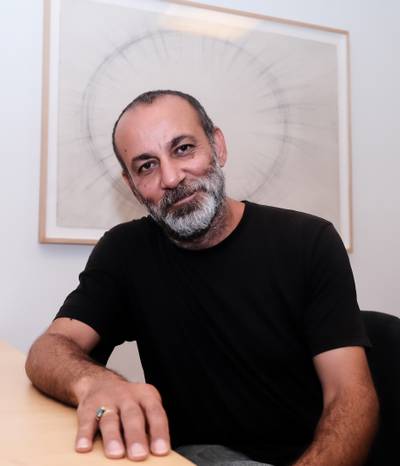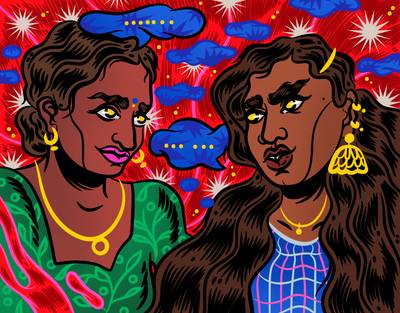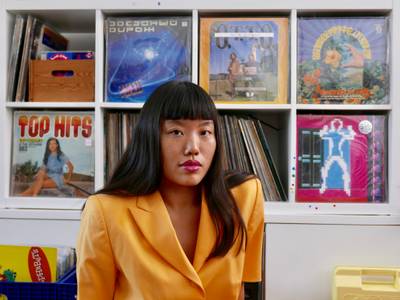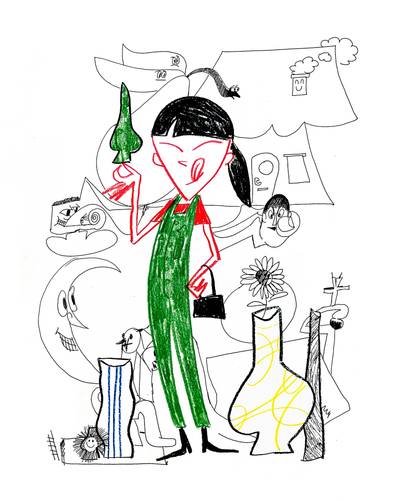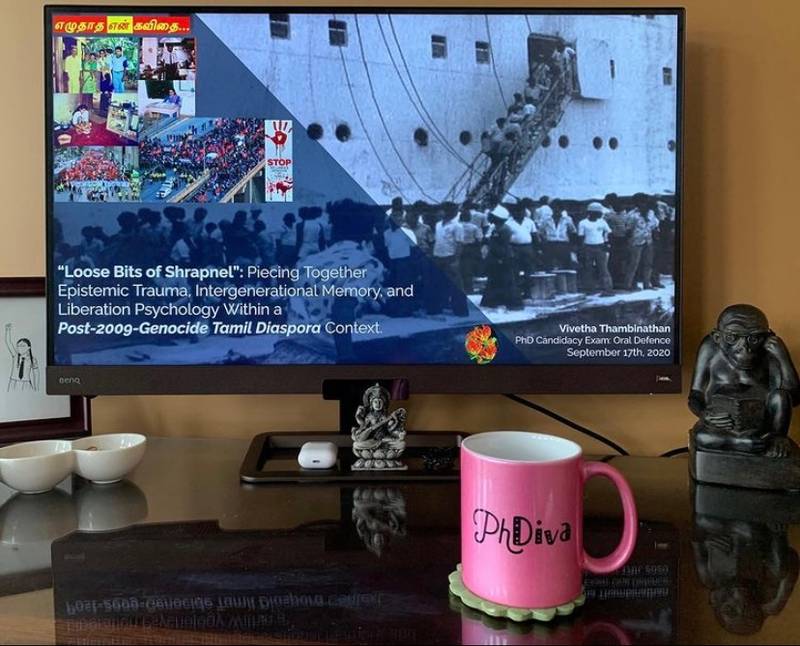

Vivetha’s desk after completing her PhD comprehensive exam
Naomi Shefali Joshi is a multi-disciplinary, Los Angeles based creative. She is passionate about and skilled in storytelling, community building, language and literature, multi/cross/intercultural communication, identity politics and making space for Black, Indigenous voices of colour. Her practice is rooted in empathy, vulnerability and collaboration.
The following interview is an intimate and vulnerable dialogue between distant friends: Naomi Joshi and Vivetha Thambinathan, back in 2020. I (Naomi) had been following the wonderful work of Vivetha through the Instagram platform she founded titled @diversityinacademia for some time and was very keen on engaging in conversation with her. I had just graduated from my master’s program and had been finding daily glimmers of comfort and visibility in Vivetha’s postings. When we finally spoke, to my surprise, an organic friendship was born as words were exchanged, from similarities and differences in our experiences to statements of solidarity, acknowledgements of pain, and an unwavering fight for healing and care. Vivetha opened her heart to me, and I feel grateful to share her unbelievably eloquent voice.
Vivetha Thambinathan is daughter to Thambinathan and Geetha, her Appa and Amma, and sister to Vipeijan, her Anna, born and raised in Canada. She’s an Eelam Tamil activist scholar, community-based researcher and critical thinker – some would even say a dreamer before thinker. But Vivetha is also a doctoral candidate in the Faculty of Health Sciences and former research director at the Washington DC-based human rights nonprofit organisation PEARL: People for Equality and Relief in Lanka. She holds a Master’s degree in Public Health. In Vivetha’s other work, she partners with research teams committed to achieving health equity for Indigenous and migrant populations through research, partnerships and policy analysis. She is the founder of Diversity in Academia (@diversityinacademia): an Instagram platform dedicated to supporting and promoting equity in higher education, standing against the notion that academia is not [just] a white man’s world. Driven by her passion for justice, Vivetha curated Diversity in Academia as a radical space to amplify a plurality of voices, focusing on counter-hegemonic perspectives – ones that are usually erased and left out in narratives shared within the academy. Vivetha feels most inspired and at home working at the intersections of community healing, creative arts-based research methods and justice.

I thought: why not start an Instagram account and see if I can find other people with similar interests? I posted memes a few times, and it blew up. People started engaging with my content, saying we want to see more of this. Many people were drawn to Diversity in Academia because it’s a carefully selected and curated account that offers counter-hegemonic perspectives and ideas within academia. The posts on the page centre not only a plurality of voices but also voices that are usually erased.
NAOMI: How did Diversity in Academia get to where it is today?
VIVETHA: My purpose and work, the stuff I’m most proud of, usually come from a place of passion and rage. It’s not a calculated pathway, which I believe makes the process authentic and genuine.
I completed my Master’s in Public Health in August 2018 and started my PhD in September. Still, as a candidate in a predominantly white university, I didn’t find other colleagues with common in-depth research interests around health, equity and justice like mine – especially for migrant populations. I had to fight to be heard or seen, which was the entry point to all of it and ultimately led me to start the platform: Diversity in Academia. I thought: why not start an Instagram account and see if I can find other people with similar interests? I posted memes a few times, and it blew up. People started engaging with my content, saying we want to see more of this. Many people were drawn to Diversity in Academia because it’s a carefully selected and curated account that offers counter-hegemonic perspectives and ideas within academia. The posts on the page centre not only a plurality of voices but also voices that are usually erased. So it becomes a space where people can be themselves and engage and comment as they please. Within the academy, I cannot perform as freely due to the risk of potential repercussions.
Diversity in Academia consists of critical & opinionated commentary on the academic world I see on Twitter. I used to say it’s like an Instagram meme page. Throughout the years, I’ve started having interactive videos and participating in community-building events virtually. So I also see it as community building, connecting and just a platform for voices that are usually left out.
Are your personal experiences within academia reflected in tweets you reshare?
Yes, for sure. The lens through which I pick my tweets is centred around the stories and experiences of being gaslit. This is healing and validating to me and many who follow Diversity in Academia.
Although we know that structural, systemic racism within academia exists, those who experience it rarely get any external validation, where others agree with you openly and wholeheartedly. I think that’s why Diversity in Academia is so appealing to so many people because they find it to be a respectful, nuanced and safe space for opening up these difficult topics.
Have you been able to build, engage with and empower a sense of community through this platform (whether online or IRL)?
This platform equips people with the tools to navigate their journey differently. For example, people reach out to me in my DMs, mainly women of colour, asking: “I’m applying to this program at this grad school, and I need someone to look over my statement", or “I want to talk to someone who’s also a woman of colour about the issues I’m facing”. I then put these requests on my IG stories. When others respond to those stories, I connect with them. Later, I got all these amazing emails from people telling me they got into universities. I’m not saying that getting into universities is the only form of validation. But still, it’s nice to see people actively using the tools they can access through this platform.
What are your thoughts on terms such as diversity & inclusion, especially considering the criticism within the current discourse toward representation politics?
Since I started the account, my thinking around this topic has evolved. I agree that institutions have co-opted and appropriated this term. To quote from Dr. Angela Davis’s speech at USC’s Bovard Auditorium: “I have a hard time accepting diversity as a synonym for justice. Diversity is a corporate strategy. It’s a strategy designed to ensure that the institution functions in the same way that it functioned before, except now that you now have some black faces and brown faces. It’s a difference that doesn’t make a difference”.
As someone who thinks critically about the politics of representation, specifically Diversity, Equity and Inclusion (DEI), I agree with your questioning of using these terms. Changing “diversity” to another term isn’t useful unless we change the frameworks we operate within and our ideas behind this mode of thinking. We must acknowledge the biases and systemic injustices in our communities, institutions and policies. I’d like to read a tweet by Professor Fleming: “Integration historically meant placing Black and Brown people in white supremacist environments, and that’s still what diversity and inclusion mean today”. By using the term ‘diversity’ within the name of the platform itself, it hopes for the inclusion of audiences who are usually left out of the conversation. However, I also don’t want to say that my account only catered to those audiences. So, in that sense, I don’t see the need to change the word for my account because I know there’s no diversity and/or inclusion without transformation and justice. And because I’m committed to that, I see that “diversity” on this platform offers an honest, alternative perspective beyond its performative syntax.
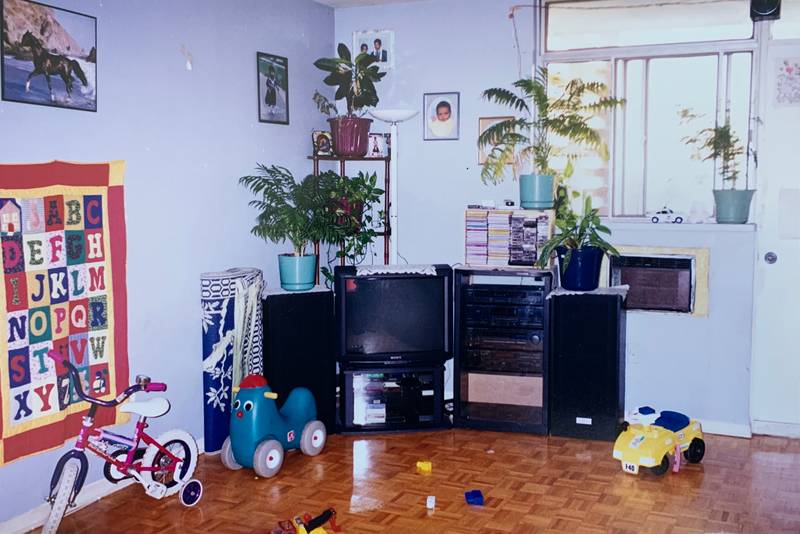

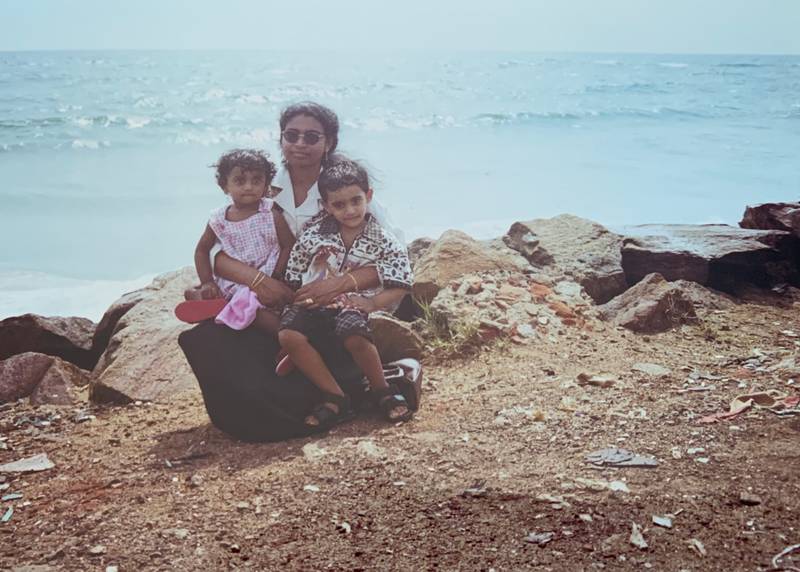

Vivetha’s first home, which shares a resemblance to many diaspora homes across the world
A fond childhood picture: Vivetha’s mother holding her and her brother in tkaranto (Toronto)
How did your Eelam Tamil identity and family history influence you to start the platform?
I grew up in Toronto, which is currently home to the largest Tamil diaspora outside Sri Lanka. Toronto is filled with Tamil convenience stores, Tamil bakeries, and Tamil supermarkets; there’s a whole plaza dedicated to Tamil shops, and even a Tamil community centre is being built. My being Eelam Tamil was always an obvious and default part of my identity; I never had to think about it until I went to university. Once I stepped into the academy, navigating those spaces as an undergrad, I felt I had to fight for representation even though I disagreed with the nuances of the politics of representation. In a predominantly white university space, I felt an indescribable loss that I had never experienced before.
While going through these difficulties, I realised there’s solidarity amongst Tamils and other Black and Brown communities. Hence, I felt that there has to be a space where the differences in our histories and struggles are recognised and where we can all speak together. That experience helped me learn more about my Eelam Tamil history, and being actively and politically involved in the struggle helped me find my identity and true understanding. The resistance and the resilience I feel in solidarity with other Eelam Tamils activated my desire to start Diversity in Academia. I was raised in an uninhibited and stable environment. It may sound paradoxical, but there was always an understanding of love within my family. I was free to say whatever was on my mind – so that’s what I considered the norm. That’s simply how I grew up. So then, going to a space where I wasn’t allowed to speak my mind was a critical motivation that gave me the drive to create and pursue a space like Diversity in Academia.
Would you be open to talking to us about your family’s migration process?
My dad was an asylum seeker. He found his way to Canada, and then he sponsored my mom. She came here, and shortly afterwards, they got married. I was born in Toronto and then lived in Scarborough, where many Tamil people reside. I was raised there for many years.
In what ways do you stay connected to your Tamil heritage?
As I described, staying connected to my Tamil heritage is not something I have had to think about when living in Toronto because there is an abundance of Tamil programming led by Eelam Tamil communities. Growing up, especially in Scarborough, you can quickly attend music classes, such as Sangeetham, or dance classes, such as Bharatanatyam. In a way, I never experienced these aspects as distinct Tamilness because they were intrinsic to my upbringing and life. I never thought about it separately. Only once I started university did I feel compelled to find ways to stay connected to my Tamil heritage – either through music or speaking in Tamil with my Tamil friends.
What roles do colorism and casteism play within the Tamil community that you grew up in?
Casteism is ongoing and widespread within the Eelam Tamil community. It is more pronounced in everyday conversations surrounding weddings or dating that if my daughter dates a person from another caste, we may be ostracised from the rest of the family, or they may not join for the celebration. Historically for Eela Tamils, caste determined who fled safely to Toronto before everyone else (upper caste) and who were sacrificed for their homeland during the armed conflict (lower caste). The Tamil liberation movement was driven by ‘lower caste’ Tamil communities, yet this is almost entirely left out in conversations about our liberation. In fact, The Liberation Tigers of Tamil Eelam (LTTE) had a clause in the Vaddukoddai resolution stating that “in the state of Tamil Eelam caste shall be abolished and the observance of the pernicious practice of untouchability or inequality of any type based on birth shall be totally eradicated and its observance in any form punished by law”. It is disheartening that the potential of this progress did not actualize, and in my opinion, we have gone backwards.
The conversation around colorism is slowly opening up between families and friends, thanks to the efforts of dark-skinned Tamils as well as Black, and dark-skinned Brown folks from other communities. But I think we are still waiting for more in the mainstream narratives. I also want to say that casteism and colourism are inherently connected, and I don’t believe that colourism could ever be eliminated without dismantling casteism first.
Regarding my own experiences: I was a competitive figure and synchronised skater. I was always the most dark-skinned person in the room, surrounded mainly by my white classmates. This situation played a definitive role in how I thought about my shade. I had to wear the white version of nude tights and leotards. Even the dresses were sewn with deliberate ignorance because it was evident that the mesh and colours they selected for the white students didn’t look right on me. In synchronised skating, they want the team to match; our clothes matched, but I stood out like a sore thumb. When we had competitions, I always ran to the only Black girl there and had these conversations.
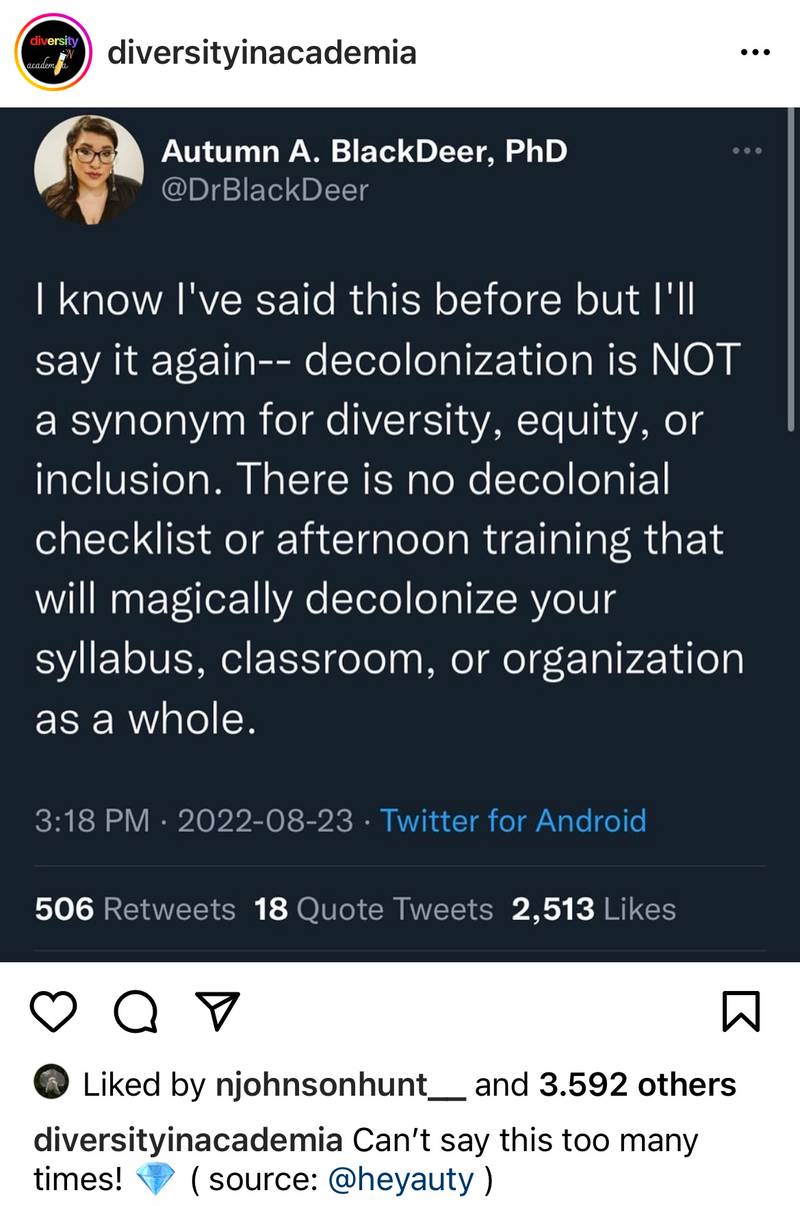

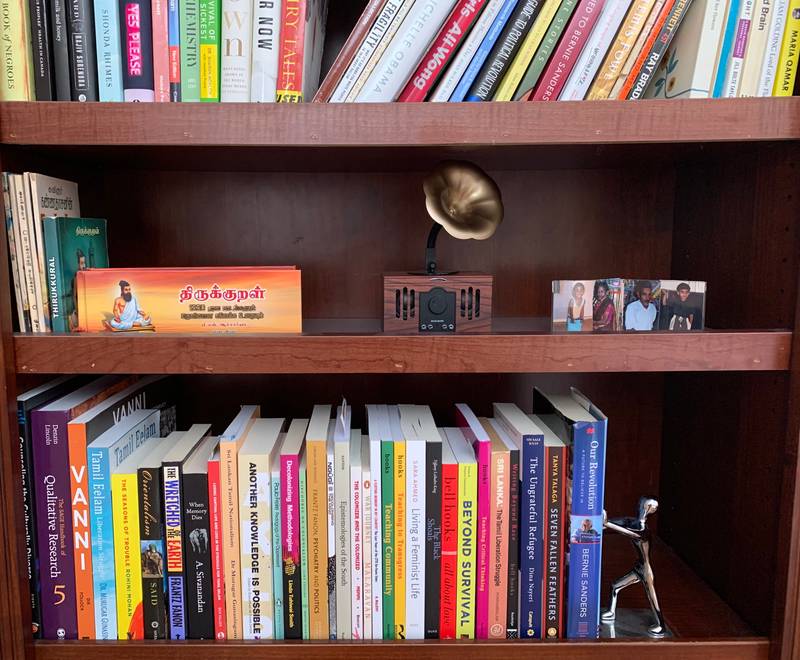

A typical @diversityinacademia post - is one that elicits critical thinking, engagement, and a sense of community among those with perspectives that are whispered within the academy instead of shouted out loud.
Vivetha’s bookshelf is filled with some gems and some mediocrity
To connect this all back to Diversity in Academia, how have harmful narratives, such as the violences of casteism and colorism, been normalised within the academic sphere? In your opinion, how should they be deconstructed and abolished?
Let’s start with hiring practices. For example, to secure a tenureship, you need to be seen as a generative machine, producing work year after year. Instead, we need a holistic understanding of different research practices, incentives and mandates so that people can remain ethical and respectful in their research practices within a community. People tend to get penalised for following their passions regarding the research that they’re doing.
Some say you can never truly reimagine and decolonise the academy because “the master’s tools will never dismantle the master’s house”. I disagree. On a macro level, some things can be done. The recent peak in response towards calls for diversity has led to increased hiring of Black and Brown professors, but not for tenureship. For a successful change, these actions have to be maintained.
On a micro level, I want to talk about the citational approach within my practice. What I mean by that is that we must rethink how we produce knowledge and what knowledge we continually engage with. So how about we don’t cite the same founding figure-white man? Instead, we engage in a different praxis, choose whom we cite, and look at different paradigms of knowledge that honour and acknowledge our voices. Dr. Christine Smith, the founder of Cite Black Women, pushed for this change in academia. You may think it’s easy to cite as per choice, but it’s almost impossible because when you want to publish it in a journal, the peer researchers, editors and publishers come back to you with comments such as: “why aren’t you citing this and this person?” So, even if you stand your ground, it might not lead to getting that paper published, which begs even broader questions, such as: what is being posted? What is produced? What is seen as knowledge?
I’m always conflicted about the space I hold in the academy. It’s this mix between feeling that I have access and power because I am in the academy and, at the same time, feeling excluded because my existence is political resistance. I also want to keep myself updated and conscious of what the younger generation says. They’re making reading groups, mobilising and engaging with texts independent of academia. No one needs to sit in a classroom led by a white professor to read Bell Hooks. Some opportunities are exclusive to the academy. It’s just something that we must continuously reflect on, think about and take action on to transgress these orders.
How has it been for you to get such overwhelmingly positive feedback? How can people who engage with your platform support the work that you’re doing?
I definitely did not expect it – I feel most validated or joyous when I read the comments and see that people feel comfortable enough to interact with and support one another respectfully.
The best support I can ask for is for social media users to continue to engage with my content and share it with the people they think would enjoy it or find it helpful.
Monetarily speaking, I have linked my Instagram bio where you can Buy Me A Coffee. The money I raise supports me in my labour and new programming for this platform.
What are your hopes and vision for the future of the platform? How do you see it growing?
I want to develop tool kits with senior academics on how early scholars and students of colour can navigate the academy without losing their soul, peace and sanity. I also want to support grad school students and early scholars in their application processes; more importantly, I aim to build a support system that can prevent burnout and scarring due to structural and systemic racism.
I’m still brainstorming what all this means. Currently, I do all the work for the platform on my own. As the work is growing, I’d like to build a team so that we can have a more comprehensive network. For this, I’m seeking funding to expand the work in a meaningful manner.
